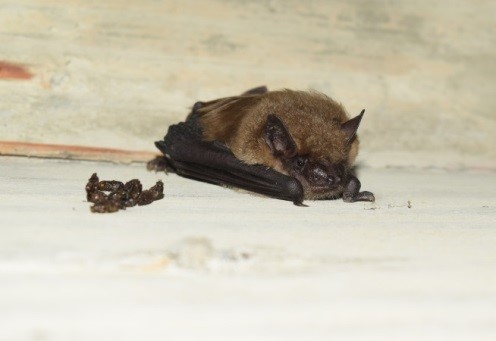Bats and bridges

Big brown bat (Eptesicus fuscus) observed on Pier 8 during active work on the St. Croix River Crossing project, Aug. 4, 2016.
Bats use a variety of habitats for day and night-time roosts, including trees, caves, and man-made structures such as bridges and buildings. Recently, during a routine annual bridge inspection, several federally protected northern long-eared bats were discovered on a Twin Cities Metro Bridge.
Bridge Inspectors and MnDOT Biologists are documenting whether or not bats are using specific bridges. Future regulations may require MnDOT to incorporate conservation measures in our bridge projects to minimize impacts to bats. It is important that we start learning about bat use of bridges now because populations are in decline due to a disease called White Nose Syndrome.
What to do if you see a bat on a bridge
If you happen to encounter a bat, here are some guidelines of what you should — and shouldn’t — do:
Leave them alone
- Bats will not attack, and pose very little risk, unless harassed. Many bites occur when people are attempting to capture or kill them.
- If you are bitten, seek medical attention immediately. The Center for Disease Control and Prevention notes that bat bites are medically urgent, though not emergencies.
- Bats can carry rabies, which humans rarely survive once symptoms set in. Symptoms can set in within as few as nine days.
Document them
- Take photos
- Record a detailed description of location
- Record the date and time of observation
- Send documentation to MnDOT Wildlife Ecologist Chris Smith.
- Reports not associated with transportation-related work can be made at the Minnesota Department of Natural Resources' Bat Observation Report page.
What indirect signs of bats might I encounter?
- Droppings (guano)
- Urine staining
- Chirping/chattering
Is it likely that I will see many bats?
No. Most bats prefer closed spaces, such as caves. Bats who reside on bridges will typically use the same bridge for their 20-30 year life span.
White nose syndrome
White nose syndrome has become a threat to hibernating bats. It appears on the muzzle and other parts of the bat during hibernation.
Bats with white nose syndrome act strangely during winter months and tend to exit their habitat and fly outside. It is estimated that white nose syndrome has been responsible for at least 5.7 million bat deaths.
